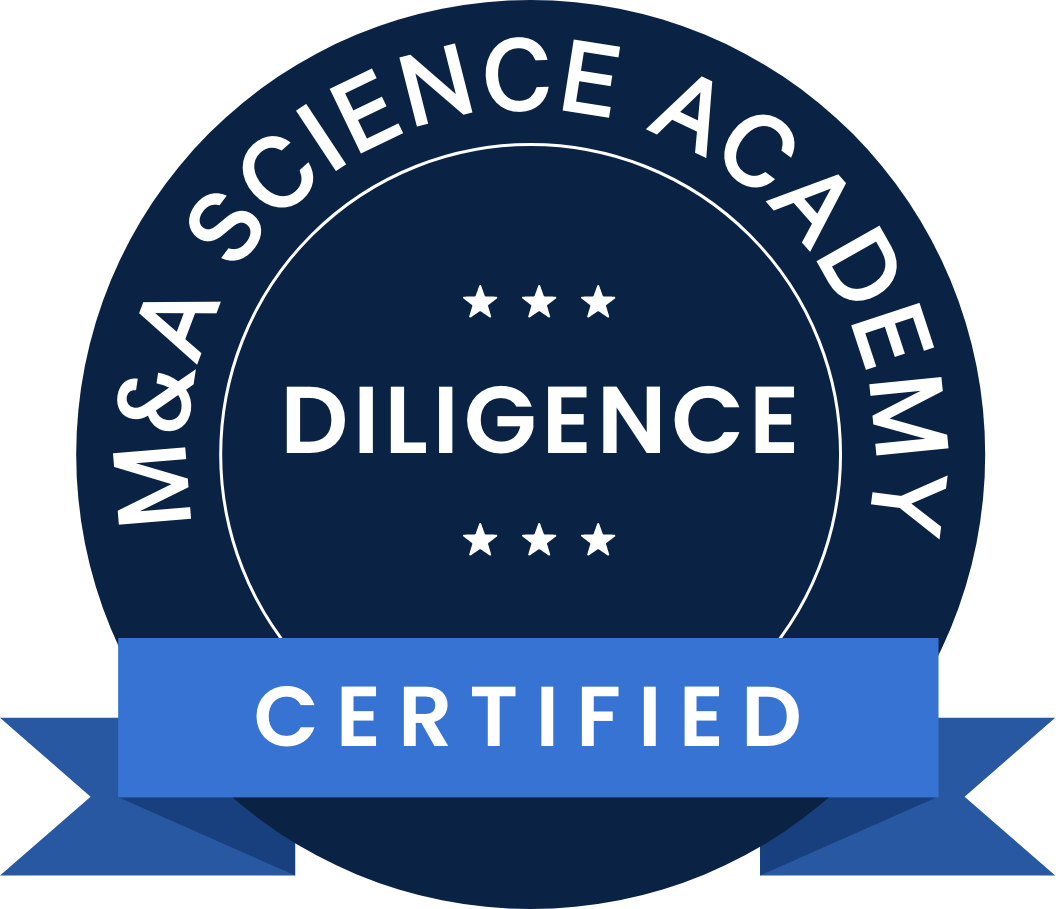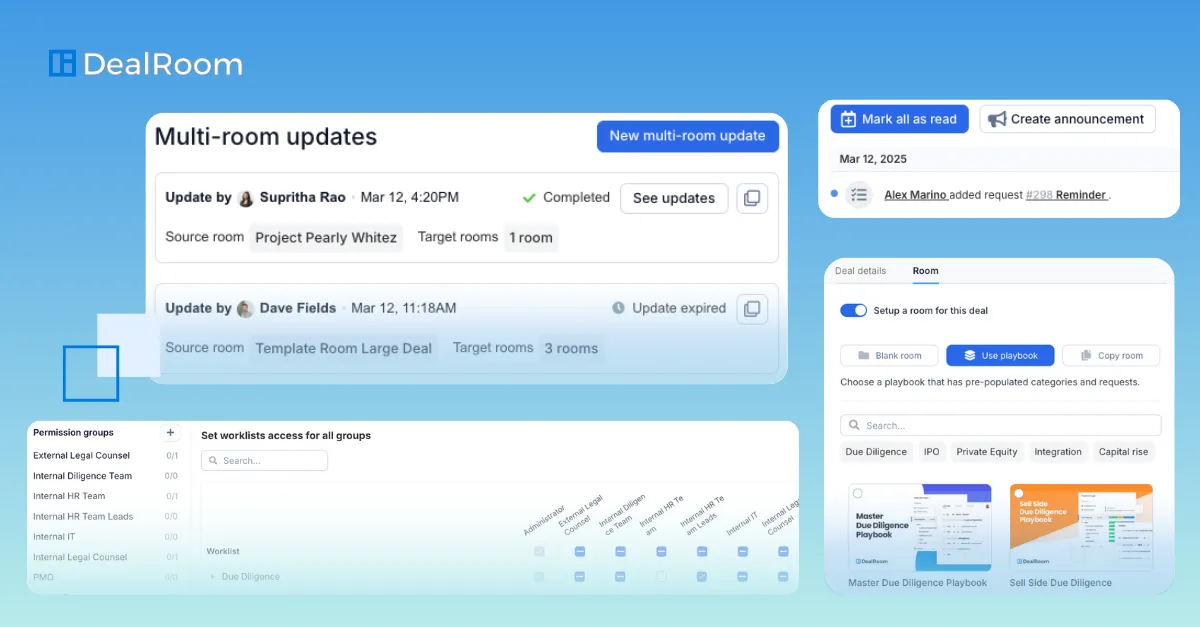Artificial intelligence (AI) is transforming corporate development by enabling smarter decision-making, uncovering new opportunities, and improving workplace efficiency. Companies use AI to predict market trends, streamline hiring, personalize employee training, and support wellness initiatives through smart wearables.
AI also plays a key role in project management and data analysis, helping leaders optimize operations. Recent studies emphasize AI’s growing impact on areas like corporate learning and employee well-being.
In this guide, we’ll explore examples of AI in corporate development, reviewing key use cases, applications, and benefits of AI technology for corporate development teams.
In this article:
- Key Functions of Corporate Development
- Examples of AI Applications in Corporate Development
- Benefits of AI in Corporate Development
- Challenges of Leveraging AI in Corporate Development
- Best Practices for AI Implementation in Corporate Development
- Future Trends in AI and Corporate Development
- Frequently Asked Questions
- Key Takeaways
Key Functions of Corporate Development

Corporate development teams drive growth and long-term value for a company. They manage key areas that support expansion, efficiency, and innovation. Here’s an overview of the key functions corporate development teams oversee.
Mergers and Acquisitions
Corporate development teams identify, evaluate, and negotiate with target companies. After closing a deal, these teams also handle integration efforts to ensure a smooth transition.
Strategic Partnerships
Building partnerships can involve forming joint ventures or signing licensing agreements. These strategic alliances often expand a company's reach or add new capabilities by leveraging shared resources.
Divestitures and Spin-Offs
At times, companies sell non-core assets or create independent spin-offs. This process helps streamline operations and allows the business to focus on core competencies.
Market Expansion
Corporate development finds new opportunities in untapped markets. It can include launching new products or developing strategies to improve the firm's positioning.
Venture Investments
Many organizations invest in startups or new technologies. These investments help the company stay ahead of fast-moving industry trends.
Financial Planning and Capital Allocation
Corporate development teams ensure efficient use of capital. They determine how to best allocate financial resources to maximize returns and support key growth projects.
The table below breaks down the key functions of corporate development.
Examples of AI Applications in Corporate Development
Artificial intelligence plays a growing role across nearly every area of corporate development. From accelerating due diligence in mergers and acquisitions (M&A) to streamlining integration, optimizing internal operations and enhancing decision-making, AI helps businesses work smarter, move faster, and adapt to change. The examples below highlight how leading companies apply AI to strengthen core functions and drive strategic growth.
Mergers & Acquisitions
AI streamlines mergers and acquisitions by quickly analyzing large datasets from target companies. It reviews financial statements, customer data, and market trends. This speeds up due diligence and can reveal hidden risks or opportunities that humans might miss.
Natural language processing tools help legal teams examine contracts for potential issues. Deal teams use predictive analytics to assess whether a merger will deliver expected returns. AI can also track public sentiment, helping executives judge market reactions to M&A announcements.
Market & Competitive Analysis
Companies use AI to monitor competitor actions and changing market conditions in real time. Machine learning models (MLMs) process news, financial reports, and customer reviews from public sources. This allows companies to spot new market entrants, emerging trends, or shifts in buyer needs sooner.
AI-generated dashboards visualize this information using charts and graphs for easy decision-making. Some businesses use AI to simulate competitor strategies, giving leaders insight into possible future moves.

Investment & Capital Allocation
Firms apply AI to guide investment and capital allocation decisions. Advanced algorithms analyze financial data, project performance metrics, and assess risk profiles. This enables leaders to deploy resources to the most promising business units or new investments.
Scenario modeling tools help forecast potential returns or losses. AI technologies can also review past spending and suggest where capital would have higher impact.
Business Process Optimization
AI tools improve business processes by identifying inefficiencies and suggesting optimizations. Robotic process automation (RPA) handles repetitive tasks like data entry, invoice processing, and customer support. This reduces manual labor and speeds up workflows.
Machine learning models monitor ongoing processes and flag outliers or bottlenecks. Leaders use this data to improve productivity and cut costs. Integrating AI with enterprise systems enables real-time adjustments, so problems are fixed as they arise.
Partnership & Alliance Development
Companies rely on AI to evaluate and manage business partnerships. Algorithms review a potential partner's financial health, reputation, and market share using public and private data. This helps organizations choose alliances with the highest strategic value.
AI analyzes joint projects to track milestones and budget adherence. If an alliance is underperforming, AI can flag issues early, allowing corporate development teams to make adjustments before the problems escalate, derail timelines, or impact strategic outcomes. Reporting tools present key data in easy-to-read formats, keeping all parties informed.
Organizational Restructuring
When a company restructures, AI maps out current resources, skill gaps, and operational inefficiencies. Data analytics tools show which teams or divisions perform well and which ones underperform.
AI models simulate the impact of shifting personnel, consolidating departments, or introducing new hierarchies. Leaders use these insights to build streamlined, effective organizations and effectively manage change.
Innovation & R&D
AI accelerates innovation by mining research, market data, and patent filings. It identifies emerging technologies and gaps in current offerings.
Companies use AI-driven trend analysis to guide product development or spot new areas for research. Automated tools help teams prioritize R&D projects based on potential impact and feasibility. AI supports simulation and prototyping, making it easier to test ideas before full-scale rollout.
Legal & Compliance Automation
AI-driven platforms automate legal research and compliance tracking. Companies use natural language processing tools to review contracts, flagging risky clauses or missing terms. AI monitors regulatory updates and analyzes impacts on operations.
Compliance bots notify teams about upcoming deadlines or required filings. Automated document review reduces lawyer workloads and errors.
DealRoom AI, for example, helps deal teams accelerate contract review during due diligence and beyond. The tool automatically extracts key terms, obligations, and risk factors from large volumes of contracts and agreements, ensuring nothing critical is overlooked. By surfacing potential compliance gaps and standardizing review across documents, it reduces contract review time by up to 80%, minimizes human error, and speeds up negotiations.
HR & Talent Acquisition
AI improves hiring and talent management by screening resumes, ranking candidates, and predicting future job performance. Machine learning tools match job postings with skill sets based on resumes and social media profiles. This helps recruiters identify strong applicants faster.
AI-powered chatbots answer candidate questions, schedule interviews, and collect feedback. AI-driven systems can also analyze internal mobility and suggest training or promotions for existing staff.
Benefits of AI in Corporate Development

Artificial intelligence offers several key benefits in corporate development.
One of the most important is enhancing strategic decision-making. AI systems help leaders by providing data-driven insights and predictive analytics.
By automating routine tasks, AI streamlines processes such as data collection, analysis, and reporting. This frees up employees’ time to focus on more complex projects.
AI helps improve efficiency and accuracy. Automating workflows reduces human error and ensures that work gets done faster and with fewer mistakes. Studies show that companies using AI have reported faster workflows and better performance in multiple sectors.
Using AI also enables scalability. Businesses can manage more projects and handle complex tasks as they grow—without hiring large numbers of new staff.
AI can bring significant cost savings to organizations. Automating labor-intensive tasks helps reduce operational costs and maintain a better cost-income ratio.
Competitive advantage is another significant benefit. Companies using AI can adapt quickly to market changes and make more informed decisions, allowing them to outperform competitors.
The table below breaks down the key benefits of AI in corporate development.
Challenges of Leveraging AI in Corporate Development
Using AI in corporate development brings many advantages, but it also creates unique hurdles. Companies often face issues related to data, technology compatibility, risks from rules and laws, fairness, skills gaps, privacy, and internal pushback.
Data Quality & Availability
AI systems depend on reliable, well-organized data to work correctly. In corporate development, data may be missing, outdated, or spread across different sources.
Collecting and cleaning this data takes time and effort. Incomplete or inaccurate records can lead to poor decisions.
Teams often struggle to get access to the full history they need, especially during mergers or when gathering third-party data. Good data governance standards are vital.
Without proper governance, AI outputs may lack value. Companies also need to follow rules about using customer and employee data, which makes data access even harder.
The table below highlights common issues with data and how these issues can impact corporate development.
Integration with Existing Systems
Many companies have legacy systems that do not work well with new AI tools. Integrating AI means connecting different databases, apps, and platforms, which can be costly and time-consuming.
Technical debt and outdated infrastructure slow the process. Teams often need to rewrite old code, reorganize software, or use middleware to get systems to communicate.
If teams do not handle integration and change management carefully, it leads to workflow disruptions. Detailed planning and flexible architecture make integration smoother.
Unexpected issues can still require extra resources and cause project delays, as explained in this analytics integration framework.
Regulatory & Compliance Risks
AI use in business must meet data privacy, financial reporting, and workplace fairness laws. Rules such as the General Data Protection Regulation (GDPR) in the European Union or the California Consumer Privacy Act (CCPA) in California require companies to manage personal information with care.
Failure to comply can lead to heavy fines and public trust issues. Teams need to monitor AI to avoid breaking these rules, especially when handling customer data or making hiring decisions.
The regulatory landscape keeps changing. Companies need experts to track new laws and update AI processes quickly to ensure ongoing compliance. This can be expensive and add extra steps to business operations.
Bias & Explainability
AI can reflect biases found in training data. Biased AI may make unfair decisions, such as favoring one group of employees over another. This puts a company at risk for lawsuits or damage to its reputation.
Explainability is another concern. Many AI models, such as deep learning, are black boxes—they give results but do not show how they made decisions. Without clear explanations, leaders may struggle to trust AI outputs.
Improving explainability helps leadership make informed choices and meet legal standards. Regular model checks and using explainable AI tools help reduce risks, which is particularly important for intelligent business strategies.
Talent & Expertise
Successful AI projects require skilled workers such as data scientists, machine learning engineers, and domain experts. There is a shortage of these talents in many markets.
Hiring and training can take months or years. Smaller businesses find it even harder, as they may not have the budget to compete with bigger firms for top talent.
Keeping up with changing technology adds to the challenge. Employees need ongoing learning to use new AI techniques and stay current with industry standards.
Security & Confidentiality
AI systems often process sensitive business data, such as financial records or trade secrets. Protecting this data from breaches is critical.
Hackers may target AI models, either by influencing results or stealing information. AI can also reveal more than intended, leaking insights to competitors or exposing private customer data by accident.
Companies must use strong security measures, including encryption, access controls, and regular audits. They should create clear policies for who can view or change the AI system and make sure vendors follow the same standards.
Adoption Resistance
Many employees worry about AI taking over jobs, changing workplace culture, or making daily tasks more complex. These fears can lead to pushback on new AI projects.
Some staff do not trust AI, especially if its actions are not transparent. Others might feel their work is devalued or fear being monitored more closely.
Clear communication, training, and including staff in the process help address these issues. Change management strategies, such as workshops and regular feedback sessions, help teams adapt and increase willingness to work with AI.
Best Practices for AI Implementation in Corporate Development

Defining AI use cases clearly is important before starting a new project. Corporate development teams should identify specific business problems that AI will solve, which helps to prioritize resources and measure success.
A company must ensure strong data governance and compliance. This includes setting data quality standards, meeting legal requirements, and protecting sensitive information. Regular audits help maintain data integrity.
Collaboration between humans and AI leads to better results. Teams should assign clear roles for both employees and AI systems.
Encouraging communication between technical and business staff helps avoid misunderstandings.
Investing in AI training and change management prepares employees for new tools and processes. Training sessions and clear communication reduce resistance to change, while ongoing support helps people adapt smoothly.
Transparency and auditability are essential. Companies should keep records of AI models, data sources, and decision processes, enabling teams to review and explain AI decisions when needed.
Monitoring and continuous improvement keep AI effective over time. Regularly tracking AI model performance helps identify problems early. Updates and retraining ensure that models stay accurate as business needs change.
A responsible approach includes mitigating ethical and bias risks in AI systems. Teams should use diverse data, test for fairness, and apply best practices in governance. Addressing these issues builds trust and supports responsible AI deployment.
Future Trends in AI and Corporate Development
AI-powered deal origination is expected to become more common. Companies will use smart algorithms to find and evaluate possible targets or partners faster than before, making it easier to spot new business opportunities.
Automated due diligence will become standard practice, with AI tools reviewing large sets of financial and legal documents in minutes instead of weeks. Platforms like DealRoom AI will play a key role, extracting obligations, risks, and critical terms from contracts at scale. This ensures deal teams catch red flags early and spend more time on strategic decisions rather than manual review.
Many organizations are beginning to depend more on AI-driven financial modeling and risk assessments. These systems use data to predict trends and spot weaknesses before they become problems.
AI will also play a bigger role in monitoring regulatory and ESG (environmental, social, and governance) compliance. With AI, companies can track changes in rules and adjust their strategies more quickly.
Stronger AI-human collaboration is likely in deal negotiations and in establishing corporate development strategy. Humans will draw on AI insights without giving up their own judgment or experience.
Finally, Explainable AI (XAI) will be used more often to audit and justify AI-driven deal recommendations, valuations, and risk ratings. XAI helps managers and regulators understand why an AI made a certain choice, building trust in automated decisions.
Frequently Asked Questions
Can AI replace human decision-makers in corporate development?
AI can quickly analyze large sets of data and suggest patterns or trends that may not be obvious, saving valuable time and resources. It can also support decision-makers by offering insights on mergers, acquisitions, or new business targets.
However, corporate development also requires judgment, negotiation skills, and understanding of complex human factors that AI cannot fully replicate. Most organizations use AI as a tool for support rather than a complete replacement for human experience.
Leaders often combine AI’s recommendations with their own expertise. For example, companies like Amazon leverage AI for market analysis, but people still make the final decisions.
What are the biggest challenges of implementing AI in corporate development?
There are several challenges organizations may face:
- Data quality - AI systems need large amounts of reliable data. Poor or incomplete data can cause mistakes.
- Integration - Combining AI tools with old systems can be complicated and may require technical changes.
- Cost - AI projects can be expensive, especially for smaller companies.
- User adoption - Employees may be slow to trust or use AI systems.
Adapting to AI in corporate settings involves more than just buying new software; overcoming these issues takes time, careful planning, and training. It also means creating a supportive culture and investing in employee skills.
How do companies ensure AI-driven decisions are ethical and unbiased?
Companies set up clear rules and checks to guard against bias. They check the data used by AI systems for any hidden prejudices and make sure results can be explained.
Teams review how decisions are made and look for patterns that seem unfair. Third-party audits and internal AI ethics boards monitor AI behavior.
Many companies offer training for staff on ethical AI practices. They build transparency and accountability into the development process to limit unfair or harmful decisions.
What industries are leading in AI adoption for corporate development?
Some industries have become early leaders in adopting AI for corporate development:
- Technology - Firms like Google and Microsoft use AI in everything from market research to mergers.
- Finance - Banks and investment groups analyze market and risk data using AI.
- Retail - Companies like Amazon apply AI to supply chain management and growth planning.
These industries often have access to large amounts of digital data. They also have resources to invest in new technology.
How can companies get started with AI in corporate development?
First, companies should define business problems that AI could help solve, such as improving deal analysis or finding new opportunities. Next, they often start with small projects or pilot programs to test what works best.
This approach allows them to learn without big risks or costs. After that, expanding the project requires investing in employee training and updating technology systems.
Partnerships or outside experts can help fill knowledge gaps. Documenting results and learning from early projects helps organizations grow their AI use over time.
What types of AI tools are commonly used in corporate development?
Several AI tools are popular in this field. Some of the most common include:
- Predictive analytics - These tools forecast trends and outcomes based on past data.
- Natural language processing (NLP) - NLP systems analyze documents and communication to find valuable information.
- Robotic process automation (RPA) - RPA tools handle repetitive tasks like data entry.
Some companies use AI-powered chatbots for internal support or due diligence checks. These tools save time and help staff focus on higher-level strategy.
What are the ethical considerations of using AI in corporate development?
Ethical concerns include privacy, data security, fairness, and transparency. Companies must protect sensitive information used by AI systems to follow laws and keep customer trust.
Companies also need to address bias in AI algorithms, which might disadvantage certain groups. Clear communication about how they use AI and continuous monitoring helps keep systems fair.
Some organizations create AI guidelines or appoint ethics committees. These steps help ensure that AI supports company goals without causing unintended harm.
Key Takeaways
- AI boosts corporate development by supporting decision-making and identifying growth opportunities.
- Common examples include personalized employee training and project management tools.
- Companies face both big benefits and key challenges when adding AI to their core functions.
As artificial intelligence becomes central to corporate development, the need for streamlined, data-driven platforms has never been greater. DealRoom helps corporate development teams fully leverage AI’s potential by integrating M&A, strategic planning, and project management into a single, collaborative workspace.
For corporate development leaders navigating mergers, spin-offs, market expansion, or investment strategy, DealRoom is built to enhance speed, accuracy, and scalability—without the burden of fragmented tools or outdated systems. As companies continue to adopt AI for smarter growth, platforms like DealRoom provide the foundation needed to turn strategy into measurable results. Book a demo today to learn more.



















.png)
.webp)



.webp)
.webp)
.webp)





.png)
.png)
.png)
.svg)

.svg)
.png)
